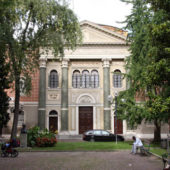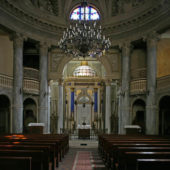A neo-classical gem anchoring the Piaza Mazzini.
There is a document dated January 26, 1368, in which a notary witnesses that one person sold a vegetable garden to another in Modena, as a cemetery for Moses, his family and his descendants. There was an earlier document which decreed on November 15, 1366, that land was granted for a Jewish burial plot. These documents testify to the fact that there were Jews in the area in the 1300s. Jewish population gradually increased from that time, because there was a law permitting Jews to be bankers. In the 1400s and 1500s the Jews lived freely in Modena, until the 17th Century, when the area began to show signs of intolerance and Jews were commanded to move into ghettos. Also at that time, a plague struck the city, decimating the Jewish population. Jews were then only allowed to perform humble occupations, such as minor money lending (heavily monitored); goldsmithing; sell furniture, art or clothing; small artisans; grain dealers; silk spinners and dyers, etc. In 1796 the French broke down the doors to the ghetto and brought the Jews the principles of equality and liberty that would free them. In 1859 all discriminatory laws against Jews were abolished.
To celebrate their newfound freedom, the Jews of Modena wanted to build a new temple, a “worthy and dignified work,” as cited in documents from the period. Ludovico Maglietta, who was renown for having designed the administration building of the provincial railway of Modena, and Ferndinando Manzini, who designed the interior of the Church of Sant’Agostino, were retained to design and build this project. Work began in 1869 and the temple was inaugurated in 1873.
Interestingly, the temple has two identical facades, one facing Piazza Mazzini, the other facing Via Coltellini. Initially, the main entrance to the synagogue was on the west side so that upon entering the sanctuary one the Aron Kodesh. When the walls of the ghetto were demolished, the congregation saw the large piazza to the south and decided that would a better entrance.
The temple’s monumental Neo-Classical architectural style was designed to stand out amongst its Christian neighbors, as the Jews were celebrating that they no longer had to hide. The synagogue’s site, with the main entrance taking central position on the Piazza Mazzini is a very bold statement in itself. Many other synagogues built in the post emancipation era reflected similar grandeur in their size and architectural styling.
The facades are graced by four imitation marble columns (scagliola), punctuated by a large wooden central doorway with decorative molded arch above, flanked by a smaller wooden door on either side. Arched windows with wrought iron balconies adorn the upstairs center of the façade. Tablets with The Ten Commandments are on the façade, under the pitch of the roof. Entering the temple from Plaza Mazzini, there are antique drawers on the walls for offerings. Inscribed upon the wall in Hebrew are the words, “He who acts with charity will find life, love and justice.” There is a stairway on the right which leads to a ritual bathtub (mikvé), and to the left, a foyer with a glass ceiling that can be opened to create a sukkah, the hut built in celebration of the High Holiday Sukkot. There are five memorial tablets on the wall. The hallway leads the sanctuary, designed to hold 1,000 people. This is a large and very formal room, with elaborate archways, and columns with Corinthian capitals, a dramatic domed ceiling painted as a lapis sky with gold stars. There is a beautifully decorated arch leading to the bema. On the platform there are three faux marble columns on each side of the Ark. Flanking the Ark are elegant lapis colored columns with gilded capitals, with ivory, lapis and gold surround. The Torah scrolls are hidden behind embroidered ivory curtains. Elegant chandeliers drop across the bema platform. There is a huge skylight just above the Ark. The Rabbi’s podium is carved wood, which complements the pews. The women’s balcony encircles nearly the entire temple.
At the beginning of the 20th Century, many Jews left Modena to live in larger cities. There is still a congregation today, but it is small, only about 60 people. Primarily elderly, they are both Ashkenazi and Sephardic. Modena Synagogue remains an important testimony to the freedom Jews have achieved in worship and their daily lives.
Photographer’s Note:
During our 2006 visit to photograph the Modena Synagogue we met the administrative director of the Jewish community, who I shall refer to as “Mrs. E”. The following are excerpts from her comments:
During WWII, only one person was sent to concentration camps. “He was known,” says Mrs. E. “He spoke loudly.” (I took this to mean he was outspoken and drew attention to himself.) The community survived the war and the synagogue was not damaged. When the Jews left to hide, they put a seal on the synagogue door. This seal was intact when the American Army liberated Modena. Seven Torahs, all hidden with families in the countryside, survived.
“The decline in the community was slow to happen,” says Mrs. E. After the war, much intermarriage took place and aliyah (especially by the very orthodox). “It’s difficult to be orthodox here,” she says. “It is so small.” Her children live in Israel. “They are very happy there. It is easy to be Jewish in Israel.” Why haven’t she and her husband joined their children? “This is our home,” she says. “We are Italians.” So, they order kosher food from Milan and work through the difficulties. (Note: we hear this from many small communities…because they are orthodox and it is difficult to maintain in the small towns, many people leave, especially the young ones, and so the communities are dying. As Mrs. E put it, “It is over for us. When we are gone, it will be the end.”)
They used to have a rabbi, but he died. His son, a surgeon, is the hazan for the community. Services are held every Shabbat and holidays. There is always a minyan. “Our congregation is very responsible,” says Sandra.
The congregation is orthodox, but traditional. There are some Sephardic, some Ashkenazic. “How does that work?” I asked. “We make accommodation,” answers Mrs. E. “My father used to say that Modena is like an island. Every person knows it is important to keep the heritage alive. Our rabbi was also very instrumental in fostering this idea of preserving the heritage and community feeling.”




